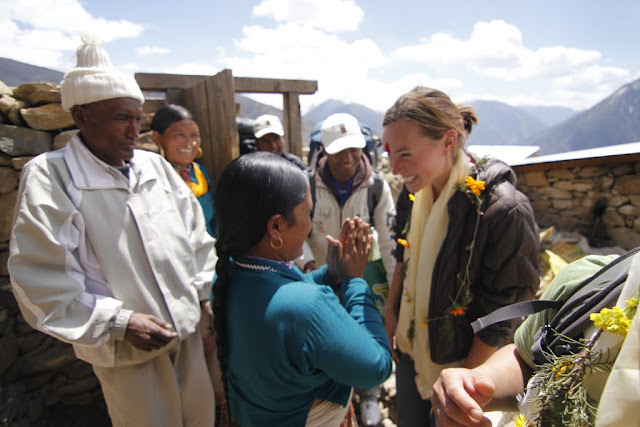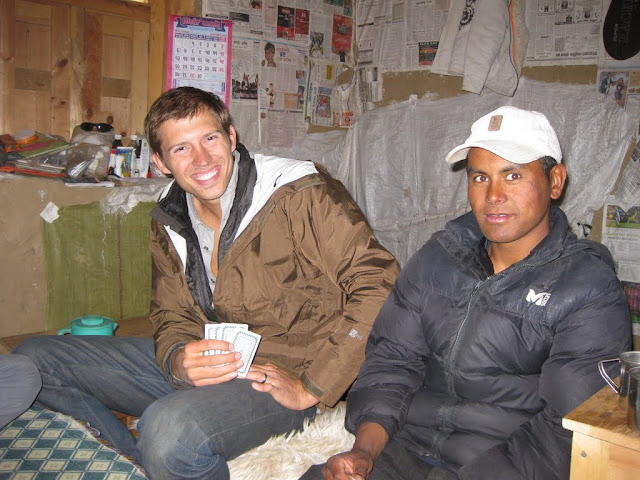The Arrival:
We stepped onto the small 9-seater plane, said a short prayer in silence and felt the plane take off. Every slight movement is multiplied in a small plane. But I completely forgot about all the jolts and noises as soon as I looked out the window. We were gliding through the air weaving between the breath taking mountains that rose from the earth and swallowed us up creating a strange sense of peace and silence within me. We made our way through the mountains and then Chimey pointed out, "There is Thehe and just in front of us is Simikot", and we started our decent gliding down into the Himalayas.
The landing was easily one of the most terrifying moments that I have ever had. The plane "crash landed" onto a very short and narrow dirt runway. But seeing as I write this now- we made it safe and received an amazing welcoming from all the staff at the NCF hostel.
The first morning we awoke and stepped out of our room to see the sun reflecting on the snow topped mountains and heard all the girls in unison say, "Good morning sir, good morning madaam". A greeting we grew to love and looked forward to every day.
Chimey was only with us for a few days so the next morning we packed a small bag and set off to hike to Thehe. The village where Namaste Children's Fund first started its work. The hike is about one and half hours for locals, so we felt good about getting to the village in just over two.
Namaste Children's Fund Brief History:
Thehe is one of the poorest villages in Humla (northwest Nepal), which is the poorest and most remote district of Nepal. Cora Edmonds visited Thehe as a photographer with a film crew researching shamans over 10 years ago. Just as she was leaving, a boy ran towards her and she took this photos:
This photo had a large impact in Cora's life, as a professional photographer and in her personal life. In short, this photograph inspired Cora and her husband Phil to trek back to Humla, Nepal to find the boy in the picture and led to the founding of a non-profit that supports his education and Thehe, the village he is from. You can read the full story
here.
Thehe has many issues stemming from over population and lack of resources. It was difficult to target specific solutions but NCF with the help of the villagers has focused its efforts on education for girls and sanitation within the village. They currently support 26 of the brighterst girls from Thehe, who now live in Simikot at a hostel where they receive an education which was normally inaccessible.
Thehe:
As we got closer to the village we could hear drum beats getting louder and louder. We turned a corner and saw a group of men and boys all jumping and playing drums, to lead us into the village. As we walked through the village more and more people joined the procession.
We finally reached the highest point in the village and my breath was completely taken away. There was an endless line of men, women and children with garlands and blessings for us. We greeted each person as they put hand made garlands around our necks and smeared red rice onto our foreheads. I could barely stay present with the moment, it was so overwhelming and unlike anything I've ever experienced.




Part of the reason we went to Thehe was to talk with the girl's parents. We wanted to ask them specific questions about their daughters participation with NCF. The intention was to have individual interviews with the parents, but that proved impossible as they all sat in a circle eager to talk and listen. So we scratched that idea and opted for a group interview. One of the most encouraging things we heard from them was a change in attitude in regards to the education of girls. It is a slow change but the parents saw that their daughters will be respected individuals and have greater opportunity because of education.
We finished the meeting and soon after Chimey and Suresh went back to Simikot leaving Tad and I with Harkha, an assistant at the hostel who helped us the rest of the time we spent in Thehe. We slept at Suresh's old home where his mother lived. She was an amazing host and a beautiful women.
We ate dinner that night in the kitchen which is an experience in itsself. To get to the kitchen you first walk through two small rooms. It gets darker and darker and as I approached the kitchen I could feel my lungs closing up from the smoke. There was one small beam of light that shines in through a small opening in the roof. It provided just enough light to see the soot and smoke that you are surrounded by. I actually tried to cover my mouth with my shirt in between bites of roti and potato curry.
We woke up to a beautiful morning, went to Harkha's mother's for breakfast then made our way back to Simikot to finally begin our month with the girls. These are some more photos from our two days in Thehe:
Teaching in Simikot:
We got back to Simikot on Saturday and had our first lesson with all the girls. Each girl made her own name tag for her bunk bed and then we worked on a group project where each girl made two matching cards for a picture and word memory game.
Chimey was with us for a few more days and helped organize the girls into five groups. That Sunday we defined our teaching schedule with all the staff and then went outside to play games and meet with each of the girls individually.
Monday kicked off three weeks of unbelievable fun making play-do, masks and other paper projects, drawing, painting, and playing games. We met with each group individually one day a week (Monday-Friday) from 10:00am to 4:00pm. On Saturdays the girls did not have class so we met as a group to do art projects, games and outdoor activities. Here's some of the best photos from our lessons.
Life In Simikot:
Ever day we woke up to the sunrise and would get our "thati pani" (boiled water) for tea or coffee. We would read a book together and have our first meal of the day.
Our meals became a rhythm within each day. The meals consisted of the same basic ingredients, but the cooks Kallie and Badam were masters and could magically turn them into three completely different meals. They were all delicious, but I don't know how they eat them year round.
Breakfast...
Lunch...
and Dinner.
Simikot is a tiny town, but it's full of life. There are people building new homes and transporting stone, (the main building material) on donkeys throughout the day. There are kids running about, men playing cards, women weaving and chatting in front of their homes and one little airstrip connecting it to the rest of Nepal. We would take walks through the town either by ourselves or with the girls from the hostel. One day we hiked up to a view point where you could see all of Simikot and the surrounding mountains.
Here's a few more photos from around the town. The kids loved making faces and seeing the photos that we would take.
During our time in Simikot we got to know the staff at the hostel really well. We had difficulty with the language barrier, but still managed to have a lot of meaningful time with each person.
The Departure:
It was the last week and we decided to do something special for the girls, Fair Day!! We had finished our last week of class and during the week each group made a paper mache' which we used for pinatas. We had a three-legged race, balloon tag, water balloon toss and a scavenger hunt. The games and the final pinata event were a huge success.
After the final games ended we walked back to the hostel and started to pack as the staff prepared for dinner. That night we all crammed into the study hall and shared our last meal together. They moved the tables and benches to one side of the room and decided that we would all preform some song or dance. That meant that we had to dance and sing as well. Luckily we all ended up dancing together most of the time and they only put us on the spot once or twice.
It was a perfect night of celebration that we will never forget. The girls and all the staff became like family to us over the month and we were so thankful for the opportunity to share life with them.

















































































